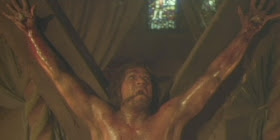 LAST DECEMBER, DASH AND I had fun watching a childhood favorite of mine, Race for Your Life, Charlie Brown. Based on that success, I decided to share another Charlie Brown flick with him: the Peanuts gang’s first full-length feature, A Boy Named Charlie Brown.
LAST DECEMBER, DASH AND I had fun watching a childhood favorite of mine, Race for Your Life, Charlie Brown. Based on that success, I decided to share another Charlie Brown flick with him: the Peanuts gang’s first full-length feature, A Boy Named Charlie Brown.Plot:
After a disastrous attempt at kite-flying and his baseball team’s 99th loss in a row, Charlie Brown (Peter Robbins) starts feeling that he’s a born loser. But that feeling changes when Linus (Glenn Gilger) convinces him to enter the school spelling bee, and he wins. As he
 advances to inter-school and national spelling bees, can Charlie Brown shake his loser ways once and for all?
advances to inter-school and national spelling bees, can Charlie Brown shake his loser ways once and for all?Critique:
All the trademark Charlie-as-loser scenarios from the classic Peanuts comic strip make appearances in A Boy Named Charlie Brown: his failed kite-flying, featuring the toothy kite-eating tree; his ill-fated attempts at pitching for his baseball team (and his clothes flying off from line drives); and his need to seek advice from Lucy’s Psychiatric Help booth.
 The script by Peanuts creator Charles Schulz is accessible to kids but doesn’t talk down to them (though a couple of segments are longer on dialogue than action or laughs). My favorite line: After Charlie Brown is clocked in the head by a line-drive baseball, someone shouts, “Does anybody know first aid?” Lucy’s response: “It’s probably not serious. Second or third aid will do.”
The script by Peanuts creator Charles Schulz is accessible to kids but doesn’t talk down to them (though a couple of segments are longer on dialogue than action or laughs). My favorite line: After Charlie Brown is clocked in the head by a line-drive baseball, someone shouts, “Does anybody know first aid?” Lucy’s response: “It’s probably not serious. Second or third aid will do.”The soundtrack features original songs by Rod McKuen (whose poetry and music were
 popular at the time), as well as the trademark Peanuts score by the Vince Guaraldi Trio.
popular at the time), as well as the trademark Peanuts score by the Vince Guaraldi Trio.Some of the animation styles leave no mystery to the fact that the film was made in the late ‘60s: Several sequences dabble in psychedelic color schemes, transitions, and type fonts.

Because of the plot, there’s a lot of word-spelling leading up to the finale – so if your kids aren't careful, they may learn something before it’s done (hey, hey, hey).
A couple of debits: The film loses some steam between the second and third acts, especially
 due to a B-story of Linus looking for his lost blanket after he and Snoopy visit Charlie Brown in the big city. And an extended, trippy sequence of historic/artistic people and places – set to Schroder playing a Beethoven piece – seems, while visually inspiring, a bit out of place.
due to a B-story of Linus looking for his lost blanket after he and Snoopy visit Charlie Brown in the big city. And an extended, trippy sequence of historic/artistic people and places – set to Schroder playing a Beethoven piece – seems, while visually inspiring, a bit out of place.In the end, Dash and I agreed: While Race for Your Life, Charlie Brown was better, A Boy Named Charlie Brown was good and worth watching.
Rating:
If Dash’s laughter is any indication, A Boy Named Charlie Brown still holds up 40 years later. From the first scene he was laughing, and continued to do so at a pretty consistent pace throughout the film.
Will your kids like it?
I highly suspect they will. Some very young kids may drop out after a certain point (like they do with many full-length movies), but kindergartners and older should find it quite enjoyable.Will your FilmMother want to watch it?
I think she’ll find A Boy Named Charlie Brown to be not only a cute, harmless, entertaining movie for the kids, but a trip down Memory Lane for herself as well.A Boy Named Charlie Brown
* Director: Bill Melendez
* Screenwriter: Charles M. Schulz
* Stars: Peter Robbins, Pamelyn Ferdin, Glenn Gilger, Andy Pforsich, Erin Sullivan, Christopher DeFaria
* MPAA Rating: G
Buy A Boy Named Charlie Brown at Half.com >>
Rent A Boy Named Charlie Brown from Netflix >>





























